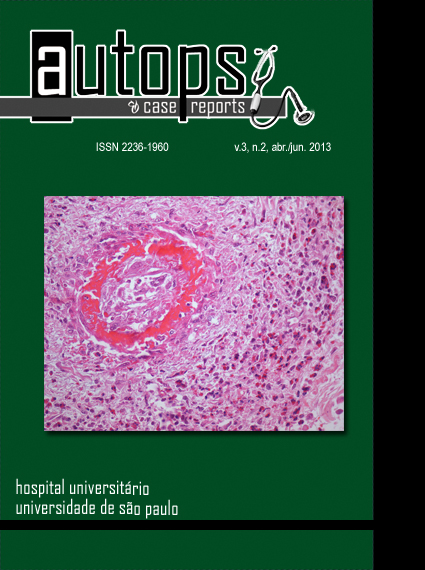Intrathoracic gastric volvulus: an autopsy case report
DOI:
https://doi.org/10.4322/acr.%25y.58911Keywords:
Stomach Volvulus, Abdominal Pain, Mediastinitis, Pancreatitis, Shock, Septic.Abstract
First described by Berti in 1866, gastric volvulus (GV) is an uncommon and potentially lethal entity. GV occurs when the stomach twists by more than 180º resulting in obstruction of the alimentary tract, visceral ischemia, necrosis, and perforation. It is classified according to the rotation axis in organoaxial, mesenteroaxial or a combination of both. The clinical presentation can be acute, and is usually severe or chronic, which sometimes may be asymptomatic. It predominantly occurs in the fifth decade of life, but children, mainly those under the age of 1 year, may be affected. No ethnicity or gender was observed to show predominance. This entity is related to gastric, diaphragmatic disorders as well as laxity of gastric ligaments. Acute GV may complicate with incarceration and strangulation of the stomach when gastric necrosis ensues. These cases show a mortality rate of 60%. The authors report the fatal case of a surgically treated GV in a 43-year-old female patient who looked for medical care only after 1 month of initial symptoms. Diagnosis was confirmed with a thoracic and abdominal axial computed tomography. Besides the entire stomach being herniated and twisted into the thoracic cavity, the pancreas was pulled up through the hiatal orifice, provoking acute pancreatitis. Because of gastric necrosis and perforation, gastroenteric fluid drained into the mediastinum and left pleural space. The postoperative outcome was unfavorable resulting in the patient’s death. The authors call attention to the severeness of the disease, and therefore the need of precocity of diagnosis and surgical treatment.Downloads
Download data is not yet available.
Downloads
Published
2013-06-25
Issue
Section
Article / Autopsy Case Report
License
Copyright
Authors of articles published by Autopsy and Case Report retain the copyright of their work without restrictions, licensing it under the Creative Commons Attribution License - CC-BY, which allows articles to be re-used and re-distributed without restriction, as long as the original work is correctly cited.
How to Cite
Ferreira, C. R., Maximiano, L. F., Santos, V. M. L. dos, & Martines, J. A. dos S. (2013). Intrathoracic gastric volvulus: an autopsy case report. Autopsy and Case Reports, 3(2), 21-29. https://doi.org/10.4322/acr.%y.58911



